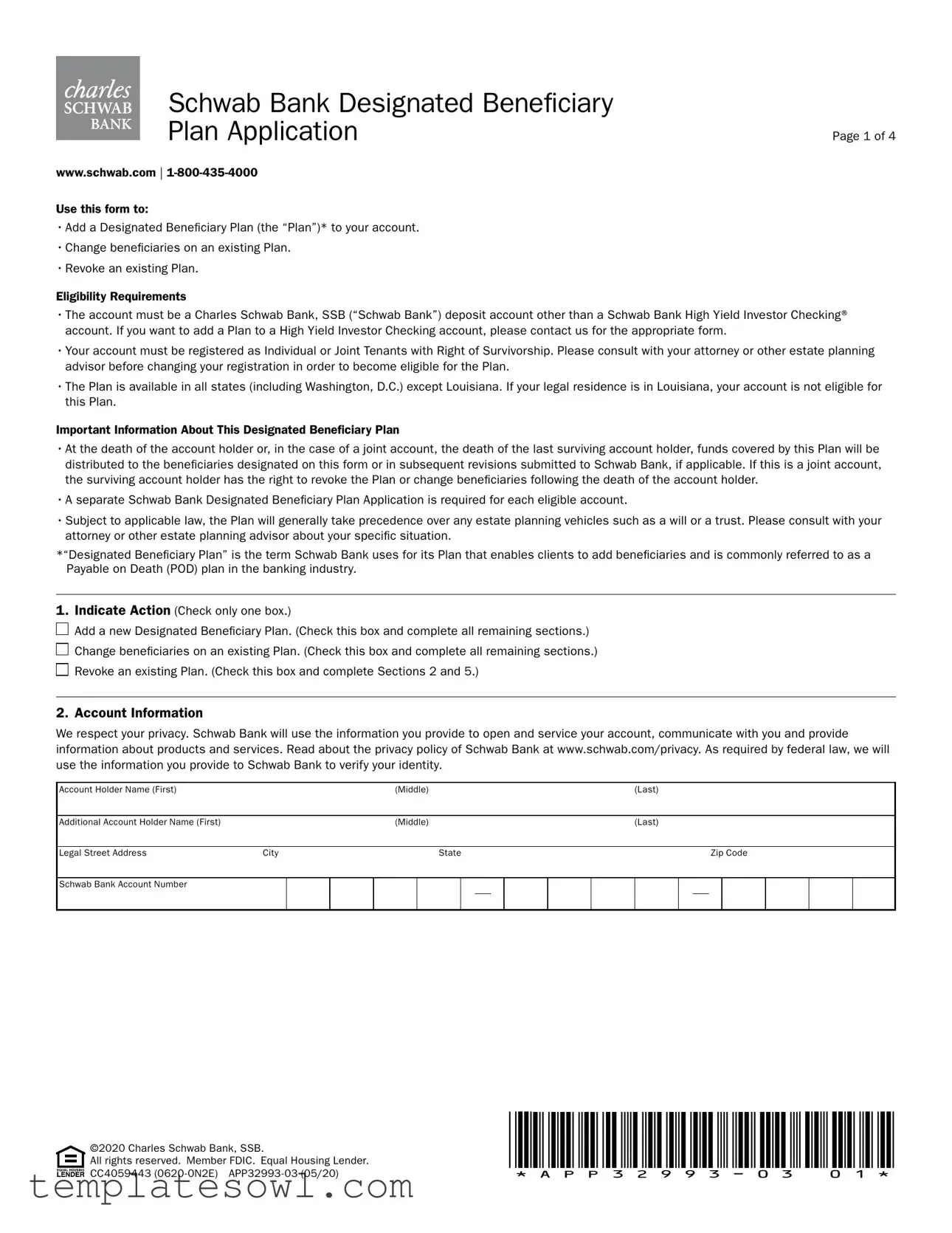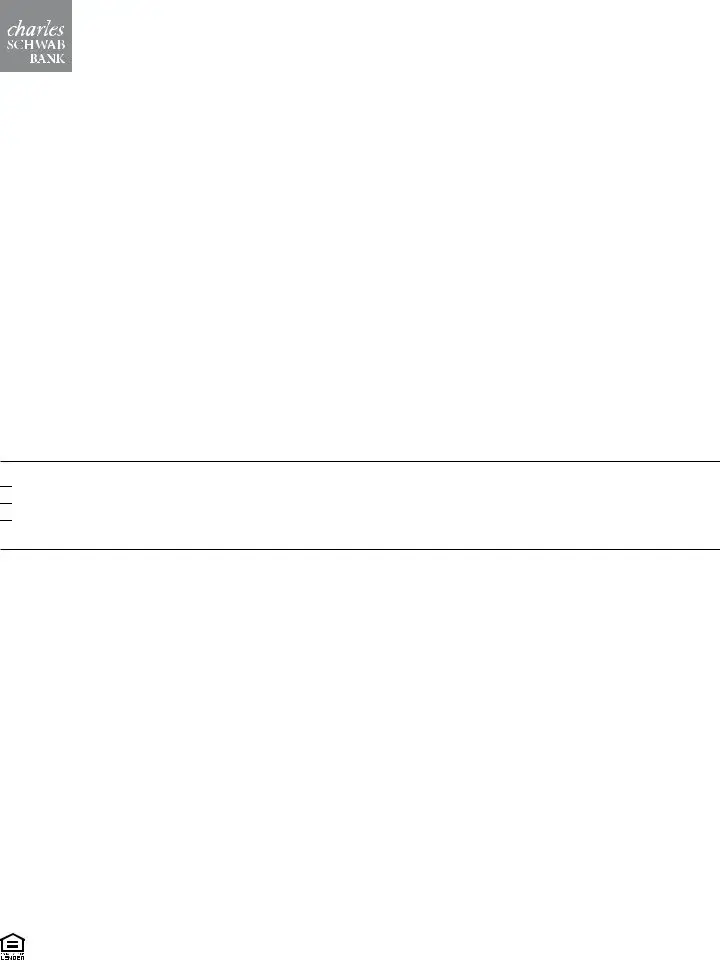Schwab Bank Designated Beneficiary |
|
Plan Application |
Page 1 of 4 |
www.schwab.com | 1-800-435-4000
Use this form to:
•Add a Designated Beneficiary Plan (the “Plan”)* to your account.
•Change beneficiaries on an existing Plan.
•Revoke an existing Plan.
Eligibility Requirements
•The account must be a Charles Schwab Bank, SSB (“Schwab Bank”) deposit account other than a Schwab Bank High Yield Investor Checking® account. If you want to add a Plan to a High Yield Investor Checking account, please contact us for the appropriate form.
•Your account must be registered as Individual or Joint Tenants with Right of Survivorship. Please consult with your attorney or other estate planning advisor before changing your registration in order to become eligible for the Plan.
•The Plan is available in all states (including Washington, D.C.) except Louisiana. If your legal residence is in Louisiana, your account is not eligible for this Plan.
Important Information About This Designated Beneficiary Plan
•At the death of the account holder or, in the case of a joint account, the death of the last surviving account holder, funds covered by this Plan will be distributed to the beneficiaries designated on this form or in subsequent revisions submitted to Schwab Bank, if applicable. If this is a joint account, the surviving account holder has the right to revoke the Plan or change beneficiaries following the death of the account holder.
•A separate Schwab Bank Designated Beneficiary Plan Application is required for each eligible account.
•Subject to applicable law, the Plan will generally take precedence over any estate planning vehicles such as a will or a trust. Please consult with your attorney or other estate planning advisor about your specific situation.
*“Designated Beneficiary Plan” is the term Schwab Bank uses for its Plan that enables clients to add beneficiaries and is commonly referred to as a Payable on Death (POD) plan in the banking industry.
1.Indicate Action (Check only one box.)

 Add a new Designated Beneficiary Plan. (Check this box and complete all remaining sections.)
Add a new Designated Beneficiary Plan. (Check this box and complete all remaining sections.)

 Change beneficiaries on an existing Plan. (Check this box and complete all remaining sections.)
Change beneficiaries on an existing Plan. (Check this box and complete all remaining sections.)

 Revoke an existing Plan. (Check this box and complete Sections 2 and 5.)
Revoke an existing Plan. (Check this box and complete Sections 2 and 5.)
2. Account Information
We respect your privacy. Schwab Bank will use the information you provide to open and service your account, communicate with you and provide information about products and services. Read about the privacy policy of Schwab Bank at www.schwab.com/privacy. As required by federal law, we will use the information you provide to Schwab Bank to verify your identity.
Account Holder Name (First) |
|
|
|
(Middle) |
|
|
|
(Last) |
|
|
|
|
|
|
|
|
|
|
|
|
|
|
|
|
|
|
|
|
Additional Account Holder Name (First) |
|
|
|
(Middle) |
|
|
|
(Last) |
|
|
|
|
|
|
|
|
|
|
|
|
|
|
|
|
|
|
|
|
Legal Street Address |
City |
|
|
|
State |
|
|
|
|
|
|
Zip Code |
|
|
|
|
|
|
|
|
|
|
|
|
|
|
|
|
|
|
|
|
Schwab Bank Account Number |
|
|
|
|
|
|
|
|
|
|
|
|
|
|
|
|
|
|
|
|
|
|
|
|
|
|
|
|
|
|
|
|
|
|
|
|
|
|
|
|
|
|
|
|
|
|
|
|
|
|
|
|
|
|
|
|
|
|
|
CC4059443 (0620-0N2E) APP32993-03 (05/20) |
*APP32993-03=01* |
©2020 Charles Schwab Bank, SSB. |
|
All rights reserved. Member FDIC. Equal Housing Lender. |
|

Page 2 of 4
3. Designate Your Primary Beneficiaries
At the death of the account holder or, in the case of a joint account, at the death of the last surviving account holder, all of the funds in the account shall be distributed to the following beneficiaries who survive the last surviving account holder by 120 hours. Unless different percentages are indicated below, the funds in the account shall be divided equally among the primary beneficiaries. If you designate more than one primary beneficiary, please make sure the percentages add up to 100%.
If you would like to list additional primary or contingent beneficiaries, please attach the information to this form. Please make sure that you clearly indicate primary beneficiaries and any contingent beneficiaries and the percentages they are to receive.
If you later wish to change one or more beneficiaries, you must complete a new Schwab Bank Designated Beneficiary Plan Application, listing all beneficiaries and their respective percentages.
Designated % |
Social Security/Tax ID Number |
|
Name (or Name of Trust and Trustees and Date of Trust) |
|
|
|
|
|
|
|
|
|
|
|
Home/Legal Street Address (no P.O. boxes, please) |
|
|
|
City |
|
|
State |
Zip Code |
|
|
|
|
|
|
|
|
|
|
Relationship |
|
|
Telephone Number |
|
|
Date of Birth (mm/dd/yyyy) |
|
|
|
|
|
|
|
|
|
Country(ies) of Citizenship (Must list all.) |
|
|
|
Country of Legal Residence |
|
USA |
Other: ___________________________ |
Other: ___________________________ |
|
USA |
Other: ________________________________ |
|
|
|
|
|
|
|
|
|
|
|
|
|
Designated % |
Social Security/Tax ID Number |
|
Name (or Name of Trust and Trustees and Date of Trust) |
|
|
|
|
|
|
|
|
|
|
|
Home/Legal Street Address (no P.O. boxes, please) |
|
|
|
City |
|
|
State |
Zip Code |
|
|
|
|
|
|
|
|
Relationship |
|
|
Telephone Number |
|
|
Date of Birth (mm/dd/yyyy) |
|
|
|
|
|
|
|
|
Country(ies) of Citizenship (Must list all.) |
|
|
|
Country of Legal Residence |
|
USA |
Other: ___________________________ |
Other: ___________________________ |
|
USA |
Other: ________________________________ |
|
|
|
|
|
|
|
|
|
|
|
|
Designated % |
Social Security/Tax ID Number |
|
Name (or Name of Trust and Trustees and Date of Trust) |
|
|
|
|
|
|
|
|
|
|
|
Home/Legal Street Address (no P.O. boxes, please) |
|
|
|
City |
|
|
State |
Zip Code |
|
|
|
|
|
|
|
|
Relationship |
|
|
Telephone Number |
|
|
Date of Birth (mm/dd/yyyy) |
|
|
|
|
|
|
|
|
Country(ies) of Citizenship (Must list all.) |
|
|
|
Country of Legal Residence |
|
USA |
Other: ___________________________ |
Other: ___________________________ |
|
USA |
Other: ________________________________ |
|
|
|
|
|
|
|
|
|
|
|
|
CC4059443 (0620-0N2E) APP32993-03 (05/20) |
*APP32993-03=02* |
©2020 Charles Schwab Bank, SSB. |
|
All rights reserved. Member FDIC. Equal Housing Lender. |
|

Page 3 of 4
4. Designate Your Contingent Beneficiaries (Optional)
If any primary beneficiary listed in Section 3 is not living at the death of the last surviving account holder, does not survive the last surviving account holder by 120 hours, or disclaims the funds, I want that beneficiary’s share to pass to (please check one):
A. The other primary beneficiary(ies) pro rata (proportionate to the designated percentages).
The other primary beneficiary(ies) pro rata (proportionate to the designated percentages).
B. My estate and go through probate.
My estate and go through probate.
C. The following contingent beneficiaries proportionate to the designated percentages indicated below.
The following contingent beneficiaries proportionate to the designated percentages indicated below.
If none of the boxes is selected, and my primary beneficiary listed in Section 3 is not living at the death of the last surviving account holder, does not survive the last surviving account holder by 120 hours, or disclaims the funds, that beneficiary’s share shall pass to the other primary beneficiary(ies) pro rata (proportionate to the designated percentages).
Unless different percentages are indicated, funds shall be divided equally among the contingent beneficiaries below.
Designated % |
Social Security/Tax ID Number |
|
Name (or Name of Trust and Trustees and Date of Trust) |
|
|
|
|
|
|
|
|
|
|
|
Home/Legal Street Address (no P.O. boxes, please) |
|
|
|
City |
|
|
State |
Zip Code |
|
|
|
|
|
|
|
|
|
|
Relationship |
|
|
Telephone Number |
|
|
Date of Birth (mm/dd/yyyy) |
|
|
|
|
|
|
|
|
|
Country(ies) of Citizenship (Must list all.) |
|
|
|
Country of Legal Residence |
|
USA |
Other: ___________________________ |
Other: ___________________________ |
|
USA |
Other: ________________________________ |
|
|
|
|
|
|
|
|
|
|
|
|
|
Designated % |
Social Security/Tax ID Number |
|
Name (or Name of Trust and Trustees and Date of Trust) |
|
|
|
|
|
|
|
|
|
|
|
Home/Legal Street Address (no P.O. boxes, please) |
|
|
|
City |
|
|
State |
Zip Code |
|
|
|
|
|
|
|
|
Relationship |
|
|
Telephone Number |
|
|
Date of Birth (mm/dd/yyyy) |
|
|
|
|
|
|
|
|
Country(ies) of Citizenship (Must list all.) |
|
|
|
Country of Legal Residence |
|
USA |
Other: ___________________________ |
Other: ___________________________ |
|
USA |
Other: ________________________________ |
|
|
|
|
|
|
|
|
|
|
|
|
Designated % |
Social Security/Tax ID Number |
|
Name (or Name of Trust and Trustees and Date of Trust) |
|
|
|
|
|
|
|
|
|
|
|
Home/Legal Street Address (no P.O. boxes, please) |
|
|
|
City |
|
|
State |
Zip Code |
|
|
|
|
|
|
|
|
Relationship |
|
|
Telephone Number |
|
|
Date of Birth (mm/dd/yyyy) |
|
|
|
|
|
|
|
|
Country(ies) of Citizenship (Must list all.) |
|
|
|
Country of Legal Residence |
|
USA |
Other: ___________________________ |
Other: ___________________________ |
|
USA |
Other: ________________________________ |
|
|
|
|
|
|
|
|
|
|
|
|
CC4059443 (0620-0N2E) APP32993-03 (05/20) |
*APP32993-03=03* |
©2020 Charles Schwab Bank, SSB. |
|
All rights reserved. Member FDIC. Equal Housing Lender. |
|
Page 4 of 4
5. Account Holder Authorization
By signing below, you request Schwab Bank to accept the beneficiaries for your account, as specified in this application (or to revoke an existing Plan, if that box is checked in Section 1 of this application). You acknowledge, read and agree to the attached Designated Beneficiary Plan Terms of Agreement With Schwab Bank. You acknowledge that you have received a copy of the Terms of Agreement.
For purposes of this application, the terms “you,” “your,” and “account holder” refer to each person who signs this application. The terms “we,” “us,” “our,” and “Schwab Bank” refer to Charles Schwab Bank, SSB.
All account holders must sign in black or blue ink only.
Signature(s) and Date(s) Required
X
Account Holder SignaturePrint NameDate
X
Additional Account Holder Signature |
Print Name |
Date |
FOR SCHWAB BANK USE ONLY:
Approved by
Schwab Bank Account Number
CC4059443 (0620-0N2E) APP32993-03 (05/20) |
*APP32993-03=04* |
©2020 Charles Schwab Bank, SSB. |
|
All rights reserved. Member FDIC. Equal Housing Lender. |
|
Designated Beneficiary Plan
Terms of Agreement With Schwab Bank
These terms relate to your account and are part of the Account Agreement between each account holder and Schwab Bank. Please retain for your files.
Throughout this agreement, the words “you,” “your” and “yours” refer to each account holder. “Schwab Bank” “we,” “us” and “our” refer to Charles Schwab Bank, SSB. Any capitalized terms not defined in these Terms of Agreement with Schwab Bank can be found in your Schwab Bank Deposit Account Agreement.
A. Amendment and Account Agreement. This Designated Beneficiary Plan Terms of Agree- ment With Schwab Bank supplements and is part of the Schwab Bank Deposit Account Agreement, an arbitration provision that you received at account opening. The Designated Beneficiary Plan With Schwab Bank (the “Plan”) consists of the Schwab Bank Designated Beneficiary Plan Application and these Terms of Agreement With Schwab Bank. If there is a conflict between the terms of the Plan and the terms of any other agreement that applies to your Schwab Bank account, the terms in the Plan shall control.
B. Limited Availability. Only Schwab Bank deposit accounts with Individual or Joint Tenants with Rights of Survivorship registrations are eligible for the Plan. Other registration types are ineligible for the Plan. Your primary residence must be within the United States in a state where Schwab Bank’s Designated Beneficiary Plan is offered. If your primary residence subsequently changes to a state where Schwab Bank’s Designated Beneficiary Plan is not offered, this Plan and your beneficiary designa- tion will no longer be valid.
C. Designation of Beneficiaries: Revocation and Changes to Beneficiary Designation. You may designate your Schwab Bank account to be payable on your death to a designated beneficiary(ies) by naming them on, and executing, the Schwab Bank Designated
Beneficiary Plan Application. These designations will remain in effect until changed or cancelled by you. During your lifetime, this account belongs to you. You may close the account, remove or add a beneficiary, change the account type or account ownership, and withdraw all or part of the account balance. Any designation, revocation or change to a beneficiary designa- tion must be authorized by all surviving account holders.
D. Payment on Death. Upon the death of the holder or, if there are co-holders, the last surviving co-holder, any Available Funds remaining in the Schwab Bank account belong to the then-surviving (if any) beneficiary(ies), subject to our right to charge the account for any amount the deceased holder, co-holder or beneficiary owes us. A beneficiary will acquire an interest in the account only after the death of all account holders and then only if the beneficiary(ies) is alive. Upon your death, the Available Funds in your account listed on this application will become the property of, and payable to, the beneficiary(ies) listed on this application who survives the last surviving account holder by 120 hours. If it cannot be determined whether a beneficiary survived the account holder by 120 hours, the beneficiary will be deemed not to have survived that period. Please be advised that surviving account holders may change the beneficiary(ies) at any time.
If there is an Overdraft Credit Line (OCL) or if you owe the bank any other debts associated with any of your deposit accounts at Schwab Bank (“Other Debts”), we may use the funds in your account (or other accounts you hold at Schwab Bank) to pay all amounts owing on your OCL or Other Debts before we distribute any funds to the beneficiary(ies).
E. Suitability for You. You acknowledge that we have not advised you on whether the Plan is appropriate for you. You acknowledge that the Plan may have significant tax, estate planning or other legal consequences. We recommend that you seek advice from your tax or estate planning advisor prior to enrolling in the Plan. You further acknowledge that this Plan does not constitute a trust and that Schwab Bank is not a trustee. Furthermore, we have no fiduciary obligations to you under this Plan.
F. Indemnity. We shall incur no liability for any payment made in good faith under this Plan. You, on behalf of yourself, your estate and your successors-in-interest, including those receiving payment as designated beneficiaries, agree to indemnify and hold harmless Schwab Bank, its affiliates and their directors, officers, employees and agents from and against all claims, actions, costs and liabilities, including attorneys’ fees, arising out of or relating to:
•your failure to notify us of a change in primary residence that may cause the Plan not to be applicable at the time of any account holder’s death;
•any conflicting designations of the funds in your Schwab Bank account by will, revocable living trust or any other instrument;
•any written change of designated beneficiaries that you have made that is not received by us during your lifetime; and
•any other claims or disputes not due to our fault or negligence.
G. Governing Law. The Plan and its provisions are effective immediately upon the execution of this application and receipt by us. These Terms of Agreement with Schwab Bank are governed by Nevada law and applicable federal law.
©2020 Charles Schwab Bank, SSB. All rights reserved. Member FDIC. Equal Housing Lender. CC4059443 (0620-0N2E) APP32993-03 (05/20) 00244458



 Add a new Designated Beneficiary Plan. (Check this box and complete all remaining sections.)
Add a new Designated Beneficiary Plan. (Check this box and complete all remaining sections.)
 Change beneficiaries on an existing Plan. (Check this box and complete all remaining sections.)
Change beneficiaries on an existing Plan. (Check this box and complete all remaining sections.)
 Revoke an existing Plan. (Check this box and complete Sections 2 and 5.)
Revoke an existing Plan. (Check this box and complete Sections 2 and 5.)

 The other primary beneficiary(ies) pro rata (proportionate to the designated percentages).
The other primary beneficiary(ies) pro rata (proportionate to the designated percentages). My estate and go through probate.
My estate and go through probate. The following contingent beneficiaries proportionate to the designated percentages indicated below.
The following contingent beneficiaries proportionate to the designated percentages indicated below.
